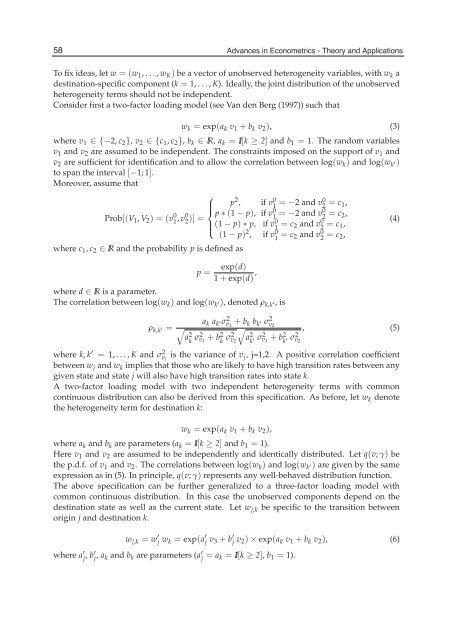The Limits of Mathematics and NP Estimation in ... - Chichilnisky
The Limits of Mathematics and NP Estimation in ... - Chichilnisky
The Limits of Mathematics and NP Estimation in ... - Chichilnisky
- No tags were found...
You also want an ePaper? Increase the reach of your titles
YUMPU automatically turns print PDFs into web optimized ePapers that Google loves.
58 Advances <strong>in</strong> Econometrics - <strong>The</strong>ory <strong>and</strong> Applications12 Will-be-set-by-IN-TECHTo fix ideas, let w =(w 1 ,...,w K ) be a vector <strong>of</strong> unobserved heterogeneity variables, with w k adest<strong>in</strong>ation-specific component (k = 1,...,K). Ideally, the jo<strong>in</strong>t distribution <strong>of</strong> the unobservedheterogeneity terms should not be <strong>in</strong>dependent.Consider first a two-factor load<strong>in</strong>g model (see Van den Berg (1997)) such thatw k = exp(a k v 1 + b k v 2 ), (3)where v 1 ∈{−2, c 2 }, v 2 ∈{c 1 , c 2 }, b k ∈ IR, a k = 1I[k ≥ 2] <strong>and</strong> b 1 = 1. <strong>The</strong> r<strong>and</strong>om variablesv 1 <strong>and</strong> v 2 are assumed to be <strong>in</strong>dependent. <strong>The</strong> constra<strong>in</strong>ts imposed on the support <strong>of</strong> v 1 <strong>and</strong>v 2 are sufficient for identification <strong>and</strong> to allow the correlation between log(w k ) <strong>and</strong> log(w k ′ )to span the <strong>in</strong>terval [−1; 1].Moreover, assume thatProb[(V 1 , V 2 )=(v 0 1 , v0 2 )] = ⎧⎪ ⎨⎪ ⎩p 2 , if v 0 1 = −2 <strong>and</strong> v0 2 = c 1,p ∗ (1 − p), if v 0 1 = −2 <strong>and</strong> v0 2 = c 2,(1 − p) ∗ p, if v 0 1 = c 2 <strong>and</strong> v 0 2 = c 1,(1 − p) 2 , if v 0 1 = c 2 <strong>and</strong> v 0 2 = c 2,where c 1 , c 2 ∈ IR <strong>and</strong> the probability p is def<strong>in</strong>ed as(4)p =exp(d)1 + exp(d) ,where d ∈ IR is a parameter.<strong>The</strong> correlation between log(w k ) <strong>and</strong> log(w k ′ ), denoted ρ k,k ′,isρ k,k ′ =a k a k ′ σ 2 v 1+ b k b k ′ σ 2 v 2√a 2 k σ2 v 1+ b 2 k σ2 v 2√a 2 k ′ σ 2 v 1+ b 2 k ′ σ 2 v 2, (5)where k, k ′ = 1, . . . , K <strong>and</strong> σv 2 jis the variance <strong>of</strong> v j , j=1,2. A positive correlation coefficientbetween w j <strong>and</strong> w k implies that those who are likely to have high transition rates between anygiven state <strong>and</strong> state j will also have high transition rates <strong>in</strong>to state k.A two-factor load<strong>in</strong>g model with two <strong>in</strong>dependent heterogeneity terms with commoncont<strong>in</strong>uous distribution can also be derived from this specification. As before, let w k denotethe heterogeneity term for dest<strong>in</strong>ation k:w k = exp(a k v 1 + b k v 2 ),where a k <strong>and</strong> b k are parameters (a k = 1I[k ≥ 2] <strong>and</strong> b 1 = 1).Here v 1 <strong>and</strong> v 2 are assumed to be <strong>in</strong>dependently <strong>and</strong> identically distributed. Let q(v; γ) bethe p.d.f. <strong>of</strong> v 1 <strong>and</strong> v 2 . <strong>The</strong> correlations between log(w k ) <strong>and</strong> log(w k ′ ) are given by the sameexpression as <strong>in</strong> (5). In pr<strong>in</strong>ciple, q(v; γ) represents any well-behaved distribution function.<strong>The</strong> above specification can be further generalized to a three-factor load<strong>in</strong>g model withcommon cont<strong>in</strong>uous distribution. In this case the unobserved components depend on thedest<strong>in</strong>ation state as well as the current state. Let w j,k be specific to the transition betweenorig<strong>in</strong> j <strong>and</strong> dest<strong>in</strong>ation k.w j,k = w ′ j w k = exp(a ′ j v 3 + b ′ j v 2) × exp(a k v 1 + b k v 2 ), (6)where a ′ j , b′ j , a k <strong>and</strong> b k are parameters (a ′ j = a k = 1I[k ≥ 2], b 1 = 1).








